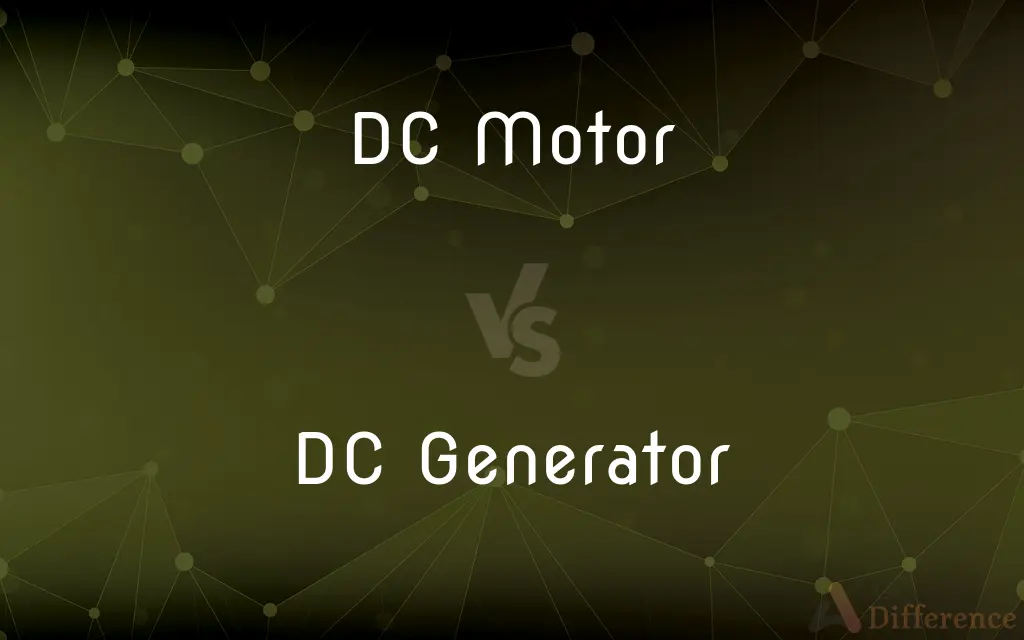DC Motor vs. DC Generator — What's the Difference?
By Tayyaba Rehman — Published on December 19, 2023
DC Motor converts electrical energy into mechanical energy, while a DC Generator transforms mechanical energy into electrical energy.

Difference Between DC Motor and DC Generator
Table of Contents
ADVERTISEMENT
Key Differences
A DC Motor is primarily designed to produce motion. This motion is derived from the electrical energy that is supplied to it. On the other hand, a DC Generator functions to produce electrical energy from a mechanical input.
The fundamental principle behind a DC Motor is that when a current-carrying conductor is placed in a magnetic field, it experiences a force. The DC Generator, conversely, works on the principle that when a conductor moves in a magnetic field, an electromotive force (EMF) or voltage is generated in it.
In a DC Motor, the input is direct current electrical energy, and the output is rotational mechanical energy. In contrast, for a DC Generator, the input is rotational mechanical energy, and the output is direct current electrical energy.
One common use of a DC Motor is to drive machinery or move objects, as seen in applications like fans, elevators, and conveyors. A DC Generator, however, is often employed in applications where mechanical energy sources, such as wind turbines or hand cranks, are used to generate electrical power.
Though the constructions of DC Motor and DC Generator are somewhat similar, with both containing an armature, commutator, and brushes, their primary applications and purposes are distinctly opposite.
ADVERTISEMENT
Comparison Chart
Primary Function
Converts electrical to mechanical energy
Converts mechanical to electrical energy
Working Principle
Force on a current-carrying conductor in a magnetic field
Generation of EMF when a conductor moves in a magnetic field
Main Input
Direct current electrical energy
Rotational mechanical energy
Main Output
Rotational mechanical energy
Direct current electrical energy
Typical Applications
Fans, elevators, conveyors
Hand cranks, wind turbines
Compare with Definitions
DC Motor
Speed can be controlled by varying the input voltage or current.
By adjusting the potentiometer, the speed of the DC Motor was varied.
DC Generator
The output voltage can be regulated by varying its speed or field strength.
To increase the output of the DC Generator, they ramped up the rotational speed.
DC Motor
Uses brushes and a commutator to regulate current direction.
To maintain the DC Motor, occasionally the brushes need replacement.
DC Generator
Contains components like armature, brushes, and a commutator.
Routine maintenance ensures the DC Generator's brushes remain effective.
DC Motor
A device that converts direct current into mechanical movement.
The toy car was powered by a small DC Motor.
DC Generator
Essential for off-grid power solutions and backup energy sources.
The windmill's DC Generator supplied power to the remote cabin.
DC Motor
Operates based on the interaction between magnetic fields and current-carrying conductors.
The DC Motor turned swiftly as the current flowed through it.
DC Generator
Operates by rotating a coil within a stationary magnetic field.
As the turbine turned, the DC Generator began producing voltage.
DC Motor
Commonly found in appliances, industrial equipment, and vehicles.
The conveyor belt's DC Motor ensured smooth operation.
DC Generator
A machine that converts mechanical energy into direct current electricity.
The hand-crank flashlight uses a DC Generator to produce light.
Common Curiosities
How does a DC Generator produce electricity?
A DC Generator generates electricity by rotating a coil within a stationary magnetic field.
Which is more efficient, a DC Motor or a DC Generator?
Efficiency varies based on design and application, but generally, modern DC Motors are more efficient.
Are the constructions of DC Motor and DC Generator similar?
Yes, both have components like an armature, commutator, and brushes, but their functions differ.
How can I increase the speed of a DC Motor?
The speed of a DC Motor can be increased by raising the input voltage.
What determines the output voltage of a DC Generator?
The output voltage can be influenced by the speed of rotation and field strength.
Where might I find a DC Generator in everyday use?
DC Generators are often found in hand-crank flashlights or off-grid power solutions.
Are DC Motors and DC Generators becoming obsolete?
While alternatives exist, DC Motors and Generators are still widely used in specific applications.
Can a DC Motor work as a DC Generator and vice versa?
With modifications, a DC Motor can work as a generator and a DC Generator as a motor, but it's not their primary function.
Can I charge a battery using a DC Generator?
Yes, a DC Generator can be used to charge a battery.
What's the main function of a DC Motor?
A DC Motor converts direct current electrical energy into mechanical energy.
Why are brushes used in both DC Motor and DC Generator?
Brushes help in transferring current between stationary and rotating parts.
How does the size of a DC Motor affect its power?
Generally, larger DC Motors can produce more power, but efficiency and design also play roles.
Do both DC Motor and DC Generator require maintenance?
Yes, both may require maintenance, especially regarding brushes and bearings.
Can I replace the DC Motor in my device with any other DC Motor?
It's crucial to choose a DC Motor with compatible specifications for voltage, speed, and torque.
Why would someone choose a DC Generator over an AC Generator?
DC Generators provide direct current, suitable for battery charging and certain electronics.
Share Your Discovery

Previous Comparison
Achievement Tests vs. Aptitude Tests
Next Comparison
Tango Dance vs. Salsa DanceAuthor Spotlight
Written by
Tayyaba RehmanTayyaba Rehman is a distinguished writer, currently serving as a primary contributor to askdifference.com. As a researcher in semantics and etymology, Tayyaba's passion for the complexity of languages and their distinctions has found a perfect home on the platform. Tayyaba delves into the intricacies of language, distinguishing between commonly confused words and phrases, thereby providing clarity for readers worldwide.












































